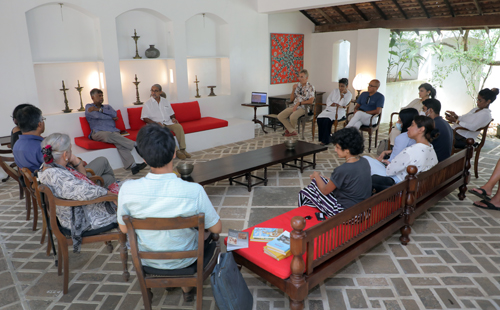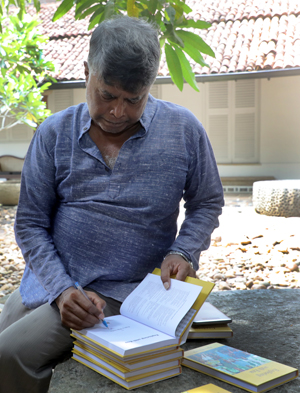A soulmate’s tribute to the vagabond spirit of Ena

Perfect setting: The book launch at Ena’s house. Pix by M.A. Pushpa Kumara
The Ena de Silva House was a watershed in Lanka’s soul search for an identity after Independence. Now relocated to Lunuganga, you enter the fort-like facade of the house that Bawa built, today called No. 5 Lunuganga and the inner courtyards speak to you as do the frangipani trees and giant bush, the harmonious marriage of the feudal walawwa, the Italian villa and the English country house – all with a peaceful antique patina that is timeless.
Here on red cushions in the living room (Bawa would have been surprised at how well the pottu vermilion goes with his ‘white and gray’) were seated two people dear to Ena and Geoffrey Bawa: Rajiva Wijesinha, writer and academic, who was relative and soul-mate to Ena; and Channa Daswatte, the Bawa protégé who also admired ‘the lady of the banners’.
The banners – mostly feudal flags which Ena dug out of ancestral pettagamas and reworked in batik with Sinhalese heraldry – were on the walls around us and heaped on a table were books by Rajiva. The occasion? The launch of Rajiva’s new book, titled Exploring with Ena.
In his 2012 book The Moonemalle Inheritance, Rajiva piquantly dug into the inheritance he shared with Ena and described some of their ‘loafing’ or ‘simple travels’ together. Here now we get the full flavour of their rambles from Thalgasmankada and Buttuwa in Yala to mystic Mandu in Central India and Shanghai.
For Rajiva it was not just the fascination with the rara avis overdressed in fantastically embroidered Kandyan or four hats and intricate jewellery, but Ena was also a ‘poet’ with whom he could discuss Rushdie and Ondaatje and enjoy the rustic splendour of Lanka just before some of her rural corners were discovered by trippers and polythene.
The only shortcoming of the book is that it keeps an unnecessary log of each and every visit made to Ena at Aluwihare (in Matale where she lived) but it is a celebration of the grand old lady and her love for life.

Author Rajiva Wijesinha
As the artist Laki Senanayake would write in one of his limerick-like poems of which he made gifts to friends, Ena always travelled “packed to the gills/ with what she calls/ “no frills”/ meals”- “Just toast and caviar/ and a few balls of condiment”. In fact she was always prepared with a cook and a veritable larder in the back of the double cab; turkey and ham beautifully garnished could appear during outings.
Special mention is made of ‘the only pudding Ena was good at” called the Humbug (a concoction of cake, cream, fruits, chartreuse, jams, ice cream and nuts), dessicated watalappam, ‘composite sandwiches’ often including polos filling and the pineapple upside down pudding which ‘in Ena’s hands turned to pure melted jaggery’.
The Aluwihare house set amidst misty blue hills, is a pervading presence in this book, with faithful retainers Suja and Piyadasa and Suja’s quasi-Michelin meals. The nest at ‘Alu’ built by Ena’s husband Sir Richard Aluwihare is where they had endless conversations, not only on books but also politics and ‘shoes and ships and ceiling wax/ and cabbages and kings’.
Yala with its simple wildlife bungalows was a favourite destination. You get something of a Colombo who’s who (the Ratwatte and Wijewardene relations predominate), though mostly it is a few kindred souls who liked leopard and bear in an evening drive by a waterhole or an ancient shrine forgotten off the beaten track.
The many memories are like golden glints dancing on a wewa at dusk from sunrises in the East Coast, loafing up Riverstone called the ‘Wireless Kanda’ by Ena, and campfire Christmases, pudding and all, at Wasgamuwa.
Rajiva actually does not give off much of the private Ena but we get to read about the fabulous wedding of her daughter Kusum when all Colombo drove up to Aluwihare. With elephants and pink champagne, it was a ‘do’ indeed with all the big Colombo architects having their ‘sheds’ (Anjalendran and Channa Daswatte had their one and so did Ismeth Raheem and Feroze Choksy).
While Ena professed to have no idea of politics she was, in fact, rather canny and her views matched Rajiva’s, though these did not align with the popular High Society sentiments.
Rajiva’s easy style comes peppered with names one is always interested to pick up from contemporary Sri Lankan history (and even world history).
Despite her delightfully theatrical panache, Ena was no prima donna and was kind to people – with some rare exceptions which Rajiva records with humour including briefly falling out with friend Mildred Tao.
Peopled with society figures and retainers, this book is a tribute to the vagabond spirit of the woman who opened our eyes to colours beyond the palette of the circumspect and the bourgeois – like Kebilitte red, bracing soft Palatupana azure, salty Okanda greens, and the wild freedom of the East Coast and the whole dry zone, where she so loved to ramble with friends and family.
Searching for an ideal partner? Find your soul mate on Hitad.lk, Sri Lanka's favourite marriage proposals page. With Hitad.lk matrimonial advertisements you have access to thousands of ads from potential suitors who are looking for someone just like you.


